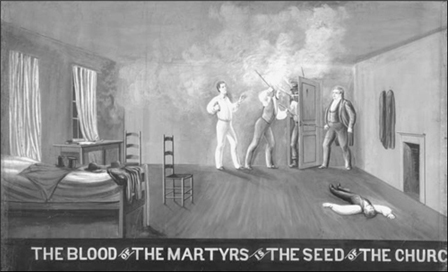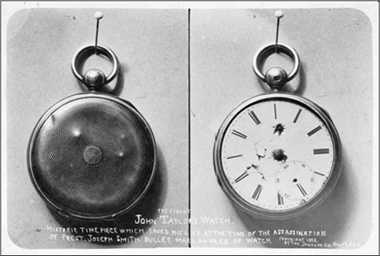American Crucifixion (27 page)
Read American Crucifixion Online
Authors: Alex Beam

The wine had the opposite of the desired effect; “We all of us felt unusually dull and languid, with a remarkable depression of spirits,” Taylor remembered. In a desperate attempt to buoy their mood, Hyrum suggested that Taylor, who had a beautiful voice, sing the popular folk hymn, “A Poor Wayfaring Man of Grief.”
In the song, the narrator generously offers food, clothing and solace to a destitute wayfarer. Ultimately, the singer finds the wayfarer locked in prison,
condemned to meet a traitor’s doom at morn
The stranger asks if his benefactor was willing to die for him;
The flesh was weak, my blood ran chill,
But the free spirit cried, “I will!”
The imprisoned stranger is Jesus Christ. Through his generosity to his savior, the singer has attained salvation.
Joseph chose this moment to ask Willard Richards if he was willing to die with him, and with Hyrum.
“Brother Joseph, you did not ask me to cross the river with you,” Richards answered. “You did not ask me to come to Carthage. You did not ask me to come to jail with you. Do you think I would forsake you now? But I will tell you what I will do; if you are condemned to be hung for treason, I will be hung in your stead, and you shall go free.”
“You can’t do that,” Joseph replied.
Repeating the affirmation from the song, Richards insisted, “I will!”
Taylor, sitting at the open, west-facing window, said he saw something: a band of men, their faces smudged, emerging from the woods and charging toward the jail. Then the Smiths and Richards heard a clamor at the bottom of the staircase.

FOURTEEN-YEAR-OLD WILLIAM HAMILTON OF THE CARTHAGE Greys, son of the innkeeper, was the first to spot the irregulars approaching the woods along the Warsaw road. Hamilton’s captain had stationed him atop the Carthage courthouse, telling him to watch for activity on the Nauvoo road, to the north. For obvious reasons, the Greys worried that Joseph’s storied Legionnaires might be invading Carthage from the northwest. By chance, Hamilton trained his field glasses in a different direction and spotted an armed force, on horseback and on foot, trailed by wagons, entering the woods on the outskirts of town, about two miles away. Thirty minutes later, around 4:30 p.m., he saw about 125 men emerging from the woods in single file, stealing alongside an old rail fence, less than a mile from the jail. The men had smeared their faces with mud and with gunpowder, and some wore their jerseys or coats turned inside out. Still, Hamilton recognized them as Warsaw militia. The boy tried to alert the Greys, but Captain Smith was nowhere to be found.
Eudocia Baldwin, whose brothers were serving in the Greys—one had just joined the six-man guard posted at the jail—reported that the Greys were either asleep, in disarray, or both. Baldwin and other Carthage residents panicked, assuming that a Mormon force of marauding “Danites” had invaded Carthage to free Joseph and exact retribution on his persecutors. Robert Smith and his lieutenant Samuel Williams finally mobilized their men in a storm of shouting and swearing. “Come on, you cowards—damn you come on!” Baldwin heard them cry. “Those boys will all be killed.”
In hindsight, William Hamilton noted that, “for one of the best drilled and equipped companies in the state at that time,” the Greys were forming ranks like a bunch of stumblebums. “I have always thought the officers and some privates were working for delay,” he wrote.
While the Greys fussed with their muskets and cartridge belts a few hundred yards away on the town common, the irregulars had already reached the jail. The jailer Stigall and Worrell’s guard offered no resistance. Someone fired shots at the jailhouse entrance, which were later determined to be either blanks or harmless warning shots aimed over the heads of Worrell’s men, who quickly fled. A bullet whistled into Mrs. Stigall’s kitchen, where she was baking bread in a Dutch oven.
The inflamed Warsaw militia—one eyewitness saw a keg of whiskey in their baggage train—stormed up the staircase to the room where the Mormons had gathered, firing their weapons as they climbed.
Dan Jones’s effort to fashion a crude latch for the second-floor door had failed. It couldn’t be locked. Richards and Hyrum Smith threw themselves against the door to keep out the angry mob, but bullets started popping through the flimsy wood. The second shot fired entered Hyrum’s skull on the left side of his nose. Simultaneously, a musket ball shot from the ground through one of the open windows hit Hyrum in the back. He fell backward, crying, “I am a dead man.” His lifeless body lay in the middle of the floor, blood pouring from his wounds.
Joseph and John Taylor rushed past Hyrum’s body to the door. Willard Richards had stationed himself behind the hinges, trying to push the door closed. But Joseph pulled out his six-shooter and started firing though the narrow opening between the door and the frame. Three of the chambers fired, and Joseph made his shots count. He wounded three assailants on the staircase, one in the arm, one in the shoulder, and another in the face. When Smith wasn’t shooting, Taylor was swinging Markham’s massive, gnarled “rascal beater” walking stick to knock down the bayonets and musket barrels poking through the cracked-open doorway.
But soon Joseph ran out of bullets. He hadn’t managed to grab Hyrum’s pistol in the melee, so now the Mormons were fighting their well-armed enemies with nothing more than muscle power, a gnarly walking stick, and a cane.
“It certainly was a terrible scene,” Taylor recalled.
Streams of fire as thick as my arm passed by me as these men fired, and, unarmed as we were, it looked like certain death. . . . It certainly was far from pleasant to be so near the muzzles of those fire-arms as they belched forth their liquid flames and deadly balls.
While I was engaged in parrying the guns, Brother Joseph said, “That’s right, Brother Taylor, parry them off as well as you can.” Those were the last words I ever heard him speak on earth.
As mobbers from the bottom of the stairs pushed forward, more musket barrels poked through the doorway. Soon the killers invaded the room. Taylor ran from the door to an open window on the north side of the jail, hoping against hope that a militia, or even the Nauvoo Legion, had come to the Mormons’ aid. He thought of jumping the fifteen feet to the ground, but he saw the jail surrounded only by blackfaced Warsaw mobbers screaming anti-Mormon curses. A bullet from the door entered his thigh and flattened itself against the bone. A second bullet flying through the window struck him in the midriff, shattering his pocket watch and propelling him back into the room. “If I had fallen out, I should assuredly have been killed,” Taylor recalled, “if not by the fall, by those around and this ball intended to dispatch me was turned by an over-ruling Providence into a messenger of mercy and saved my life.”

A famous 1878 painting by Danish convert C. C. Christensen depicts Hyrum Smith slain in the Carthage jail cell; Joseph, dressed in white, symbolizing his innocence; John Taylor batting down musket barrels with his cane; and Willard Richards hiding behind the cell door.
Credit: Brigham Young University Art Museum
Falling to the floor, the blood-spattered Taylor rolled under the bed for safety. The mob fired two more bullets into him, “cutting away a piece of flesh from his left hip as large as a man’s hand,” Richards reported. Taylor was left for dead, his watch stopped at 5:16 p.m.
Desperately hoping for safety, Joseph Smith followed Taylor to the window, planning to jump. A mobber named Gallagher shot him in the back from the doorway, and shots from the ground struck Joseph in the chest and back. Smith tumbled out the window, crying, “O Lord my God,” the first words of the Masonic cry for help, “O Lord my God, is there no help for the widow’s son?” His body fell near a raised wooden curb surrounding a well.
There was to be no pity for the widowed Lucy Mack’s son. Mobber William Voorhis grabbed Joseph’s body and propped it up against the well. Then he exposed Joseph’s bloody chest to the angry mob.

John Taylor’s watch, shattered in the melee at the Carthage Jail
Credit: LDS Church History Library
“You are the damned old Chieftain,” Voorhis taunted the half-dead body of Joseph Smith, “Now go see your spiritual wives in hell!” Voorhis stood aside and watched a handful of his comrades fire several more rounds into Joseph’s lifeless body.
*
*
The mob had come for Joseph, and Joseph was dead. The mission was over. Inside Stigall’s chambers, Richards was still huddling behind the door. Barely wounded—he had suffered only a minor scratch on his earlobe—he heard the killers clamber back down the jailhouse stairwell. After a few moments, he ventured, tentatively, to the window. He saw a hundred men gathered around Joseph’s lifeless body. Just then, he heard Taylor’s voice from under the bed.
“Stop, Doctor, take me along,” Taylor said.
With the two men alone in the jailhouse, Richards dragged Taylor’s bullet-ridden body into the adjoining cell and pulled a filthy mattress over him.
“That may hide you, and you may yet live to tell the tale,” Richards said. “I expect they will kill me in a few moments.”
Having climbed down from his rooftop perch on the courthouse, the young William Hamilton rushed to the scene. From fifty yards away, he saw Joseph Smith tumble from the second-floor window. He saw someone prop Joseph’s body up against the low wall surrounding the jailhouse well. “He’s dead,” a mobber grunted, and the attackers vanished as quickly as they came.
Hamilton entered the jail and “found Hyrum Smith lying upon the floor on his back, dead.” He didn’t look into the adjoining cell, where Richards and Taylor were hiding. “After I had satisfied my curiosity, seen and been among the mob, seen the prophet shot, and seen the dead men, it occurred to me I ought to go home and tell the news,” Hamilton recalled. Two hundred yards from the jail, he encountered his comrades-in-arms, the Greys, finally approaching the scene. He suggested they “about face” and return to their encampment; “Their prisoners were dead and not likely to run away.”
The faked confrontation with the guards, the siege up the staircase, the slaughter of the Mormons and the brief ogling of the dead Prophet’s body consumed three minutes. When Richards eventually descended the staircase and reconnoitered around the jail, he saw that the mob had vanished as quickly as it had struck. At precisely this moment, Robert Smith’s Carthage Greys appeared on the scene, just “in time to see the rear portion of the mob disappearing in the distance,” Eudocia Baldwin recounted.

Other books
Look How You Turned Out by Diane Munier
Letters to My Torturer: Love, Revolution, and Imprisonment in Iran by Houshang Asadi
Off to Be the Wizard - 2 - Spell or High Water by Scott Meyer
On Mother Brown's Doorstep by Mary Jane Staples
Honesty - SF8 by Meagher, Susan X
Elephants can't hide forever by Peter Plenge
Showjumpers by Stacy Gregg
Hotel Pastis by Peter Mayle
Numbered Account by Christopher Reich
Dragons & Dwarves by S. Andrew Swann
